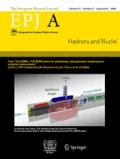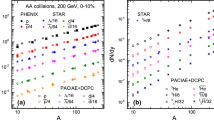Abstract
Using a transport model that includes a first-order chiral phase transition between the partonic and the hadronic matter, we study the development of density fluctuations in the matter produced in heavy ion collisions as it undergoes the phase transition, and their time evolution in later hadronic stage of the collisions. With the production of deuterons and tritons described by the coalescence model from nucleons at kinetic freeze out, we find that the yield ratio \( N_\text {t}N_\text {p}/ N_\text {d}^2\), where \(N_\text {p}\), \(N_\text {d}\), and \(N_\text {t}\) are, respectively, the proton, deuteron, and triton numbers, is enhanced if the evolution trajectory of the produced matter in the QCD phase diagram passes through the spinodal region of a first-order chiral phase transition.








Similar content being viewed by others
Data Availability Statement
This manuscript has no associated data or the data will not be deposited. [Authors’ comment: Data from theoretical simulations are available upon request.]
References
E.V. Shuryak, Phys. Rept. 61, 71 (1980)
P. Braun-Munzinger, V. Koch, T. Schaefer, J. Stachel, Phys. Rept. 621, 76 (2016)
A. Bzdak, S. Esumi, V. Koch, J. Liao, M. Stephanov, N. Xu, Phys. Rept. 853, 1 (2020)
Y. Aoki, G. Endrodi, Z. Fodor, S.D. Katz, K.K. Szabo, Nature 443, 675 (2006)
M. Asakawa, K. Yazaki, Nucl. Phys. A 504, 668 (1989)
K. Fukushima, Phys. Rev. D 77, 114028 (2008a), [Erratum: Phys. Rev. D 78, 039902(2008)]
M. A. Stephanov, Prog. Theor. Phys. Suppl. 153, 139 (2004), [Int. J. Mod. Phys.A20,4387(2005)]
I.N. Mishustin, Phys. Rev. Lett. 82, 4779 (1999)
P. Chomaz, M. Colonna, J. Randrup, Phys. Rept. 389, 263 (2004)
C. Sasaki, B. Friman, K. Redlich, Phys. Rev. Lett. 99, 232301 (2007)
J. Steinheimer, J. Randrup, Phys. Rev. Lett. 109, 212301 (2012)
C. Herold, M. Nahrgang, I. Mishustin, M. Bleicher, Nucl. Phys. A 925, 14 (2014)
F. Li, C.M. Ko, Phys. Rev. C 95, 055203 (2017)
M. Nahrgang, C. Herold, Eur. Phys. J. A 52, 240 (2016)
J. Steinheimer, L. Pang, K. Zhou, V. Koch, J. Randrup, H. Stoecker, JHEP 12, 122 (2019)
M.A. Stephanov, K. Rajagopal, E.V. Shuryak, Phys. Rev. Lett. 81, 4816 (1998)
M.A. Stephanov, Phys. Rev. Lett. 107, 052301 (2011)
B. Berdnikov, K. Rajagopal, Phys. Rev. D 61, 105017 (2000)
M. Asakawa, M. Kitazawa, B. Mueller, Phys. Rev. C 101, 034913 (2020)
X. Luo, S. Shi, N. Xu, Y. Zhang, Particles 3, 278 (2020)
L.-G. Pang, K. Zhou, N. Su, H. Petersen, H. Stoecker, X.-N. Wang, Nat. Commun. 9, 210 (2018)
Y.-L. Du, K. Zhou, J. Steinheimer, L.-G. Pang, A. Motornenko, H.-S. Zong, X.-N. Wang, H. Stocker, Eur. Phys. J. C 80, 516 (2020)
M.A. Stephanov, Phys. Rev. Lett. 102, 032301 (2009)
J. Adam et al., STAR. Phys. Rev. Lett. 126, 092301 (2021)
J. Steinheimer, J. Randrup, V. Koch, Phys. Rev. C 89, 034901 (2014)
K.-J. Sun, L.-W. Chen, C.M. Ko, Z. Xu, Phys. Lett. B 774, 103 (2017)
K.-J. Sun, L.-W. Chen, C.M. Ko, J. Pu, Z. Xu, Phys. Lett. B 781, 499 (2018)
E. Shuryak, J.M. Torres-Rincon, Phys. Rev. C 100, 024903 (2019a)
E. Shuryak, J. M. Torres-Rincon Phys. Rev. C 101, 034914 (2019)
T. Anticic et al., NA49. Phys. Rev. C 94, 044906 (2016)
D. Zhang (STAR), Nucl. Phys. A 1005, 121825 (2021)
M. Nahrgang, PoS CPOD2014, 032 (2015)
M. Bluhm et al., Nucl. Phys. A 1003, 122016 (2020)
K. Murase, T. Hirano, Nucl. Phys. A 956, 276 (2016)
M. Nahrgang, M. Bluhm, T. Schaefer, S. Bass, Acta Phys. Polon. Supp. 10, 687 (2017)
M. Singh, C. Shen, S. McDonald, S. Jeon, C. Gale, Nucl. Phys. A 982, 319 (2019)
Y. Akamatsu, A. Mazeliauskas, D. Teaney, Phys. Rev. C 95, 014909 (2017)
X. An, G. Basar, M. Stephanov, H.-U. Yee, Phys. Rev. C 100, 024910 (2019)
M. Stephanov, Y. Yin, Phys. Rev. D 98, 036006 (2018)
K. Rajagopal, G. Ridgway, R. Weller, Y. Yin, Phys. Rev. D 102, 094025 (2020)
M. Nahrgang, M. Bluhm, T. Schaefer, S.A. Bass, Phys. Rev. D 99, 116015 (2019)
Y. Nambu, G. Jona-Lasinio, Phys. Rev. 122, 345 (1961a)
Y. Nambu, G. Jona-Lasinio, Phys. Rev. 124, 246 (1961b)
C.M. Ko, T. Song, F. Li, V. Greco, S. Plumari, Nucl. Phys. A 928, 234 (2014)
J. Xu, T. Song, C.M. Ko, F. Li, Phys. Rev. Lett. 112, 012301 (2014)
Z.-W. Lin, C.M. Ko, B.-A. Li, B. Zhang, S. Pal, Phys. Rev. C 72, 064901 (2005)
B.-A. Li, C.M. Ko, Phys. Rev. C 52, 2037 (1995)
K.-J. Sun, C.M. Ko, Z.-W. Lin, Phys. Rev. C 103, 064909 (2021)
K. Fukushima, Phys. Rev. D 77, 114028 (2008b)
F. Li, C.M. Ko, Phys. Rev. C 93, 035205 (2016)
M. Buballa, Phys. Rept. 407, 205 (2005a)
G. ’t Hooft, Phys. Rev. D 14, 3432 (1976)
M. Buballa, Phys. Rept. 407, 205 (2005b)
K. Masuda, T. Hatsuda, T. Takatsuka, PTEP 2013, 073D01 (2013)
U. Vogl, W. Weise, Prog. Part. Nucl. Phys. 27, 195 (1991)
N.M. Bratovic, T. Hatsuda, W. Weise, Phys. Lett. B 719, 131 (2013)
M.F.M. Lutz, S. Klimt, W. Weise, Nucl. Phys. A 542, 521 (1992)
X.-Y. Xin, S.-X. Qin, Y.-X. Liu, Phys. Rev. D 90, 076006 (2014)
C.S. Fischer, J. Luecker, C.A. Welzbacher, Phys. Rev. D 90, 034022 (2014)
W.-J. Fu, J.M. Pawlowski, F. Rennecke, Phys. Rev. D 101, 054032 (2020)
F. Gao, J.M. Pawlowski, Phys. Rev. D 102, 034027 (2020)
J. Grefa et al., Phys. Rev. D 104, 034002 (2021)
C.M. Ko, Q. Li, R.-C. Wang, Phys. Rev. Lett. 59, 1084 (1987)
C.-M. Ko, Q. Li, Phys. Rev. C 37, 2270 (1988)
A. Buck, R. Alkofer, H. Reinhardt, Phys. Lett. B 286, 29 (1992)
C.-Y. Wong, Phys. Rev. C 25, 1460 (1982)
G. Bertsch, S. Das Gupta, Phys. Rept. 160, 189 (1988)
J. Aichelin, Phys. Rept. 202, 233 (1991)
P. Rehberg, S.P. Klevansky, J. Hufner, Phys. Rev. C 53, 410 (1996)
A. Abada, J. Aichelin, Phys. Rev. Lett. 74, 3130 (1995)
R. Marty, J. Aichelin, Phys. Rev. C 87, 034912 (2013)
G. Ropke, Phys. Rev. C 79, 014002 (2009)
K.-J. Sun, L.-W. Chen, Phys. Lett. B 751, 272 (2015)
K.-J. Sun, L.-W. Chen, Phys. Rev. C 95, 044905 (2017)
G. Röpke, D. Blaschke, Y.B. Ivanov, I. Karpenko, O.V. Rogachevsky, H.H. Wolter, Phys. Part. Nucl. Lett. 15, 225 (2018)
M. Asakawa, M. Kitazawa, Prog. Part. Nucl. Phys. 90, 299 (2016)
P.A.R. Ade et al., Planck. Astron. Astrophys. 571, A1 (2014)
D. Baumann, in Physics of the large and the small, TASI 09, proceedings of the Theoretical Advanced Study Institute in Elementary Particle Physics, Boulder, Colorado, USA, 1–26 2009, pp. 523–686 (2011)
C. Herold, M. Nahrgang, I. Mishustin, M. Bleicher, Phys. Rev. C 87, 014907 (2013)
H. Liu, D. Zhang, S. He, N. Yu, X. Luo, Phys. Lett. B 805, 135452 (2020)
W. Zhao, C. Shen, C.M. Ko, Q. Liu, H. Song, Phys. Rev. C 102, 044912 (2020)
J. Adam et al., STAR. Phys. Rev. C 99, 064905 (2019)
D. Zhang (STAR), JPS Conf. Proc. 32, 010069 (2020)
E. Shuryak, J. M. Torres-Rincon (2020)
K.-J. Sun, C.-M. Ko, S. Cao, F. Li, Phys. Rev. D 103, 014006 (2021)
D. Oliinychenko, L.-G. Pang, H. Elfner, V. Koch, Phys. Rev. C 99, 044907 (2019)
D. Oliinychenko, Nucl. Phys. A 1005, 121754 (2021)
W. H. Zhou, H. Liu, F. Li, Y. F. Sun, J. Xu, C. M. Ko, Phys. Rev. C 104, 044901(2021)
Acknowledgements
The ECT* Trento has supported this work and this infrastructure is part of a project that has received funding from the European Union’s Horizon 2020 research and innovation programme under grant Agreement No 824093. One of the authors K.J.S. thanks Jorgan Randrup and Xiao-Feng Luo for helpful discussions. This work was supported in part by the US Department of Energy under Contract No.DE-SC0015266, the Welch Foundation under Grant No. A-1358, the National Natural Science Foundation of China under Grant No. 11922514 and No. 11625521, and National SKA Program of China No. 2020SKA0120300.
Author information
Authors and Affiliations
Corresponding author
Additional information
Communicated by David Blaschke.
Appendix A: Density fluctuations and light nuclei production in the thermal model
Appendix A: Density fluctuations and light nuclei production in the thermal model
In the conventional thermal model for particle production in relativistic heavy ion collisions, the produced matter is assumed to be in global thermal and chemical equilibrium and to have a uniform density distribution. The effect of density fluctuations can be included in this model by assuming that the produced matter is in local thermal and chemical equilibrium with a space dependent temperature \(T(\mathbf{x})\) and chemical potential \(\mu (\mathbf{x})\). For the simplified case of a constant temperature, the nucleon number density is given by
where \(K_2\) is the modified Bessel function of second kind and \(\mu _{n,p}(\mathbf{x})\) denotes the space dependent chemical potentials for neutron and proton. Assuming that deuterons and tritons are in local thermal and chemical equilibriums with the nucleons, their number densities in this model are then
The yield ratio \(\mathcal {O}_{\text {p-d-t}}= N_\text {t}N_\text {p}/N_\text {d}^2 \) can be calculated in the non-relativistic approximation as
which is identical to Eq. (23) obtained from the nucleon coalescence model. Density fluctuations thus affect the yield ratio \(N_\text {t}N_\text {p}/N_\text {d}^2 \) similarly in both the coalescence and the thermal model.
The above derivation is based on the assumption that the local chemical equilibrium among protons, deuterons, and tritons is maintained from chemical freeze out until kinetic freeze out as a result of the large production and dissociation cross sections of deuterons and tritons during the hadronic evolution [86]. If one assumes instead that the yields of deuterons and tritons produced at the chemical freeze out of identified hadrons remain unchanged during hadronic evolution as assumed in usual statistical hadronization model, there is an additional factor in Eq. (A3) from the contribution of resonance decays to protons [87].
Rights and permissions
About this article
Cite this article
Sun, KJ., Ko, C.M., Li, F. et al. Enhanced yield ratio of light nuclei in heavy ion collisions with a first-order chiral phase transition. Eur. Phys. J. A 57, 313 (2021). https://doi.org/10.1140/epja/s10050-021-00607-4
Received:
Accepted:
Published:
DOI: https://doi.org/10.1140/epja/s10050-021-00607-4



